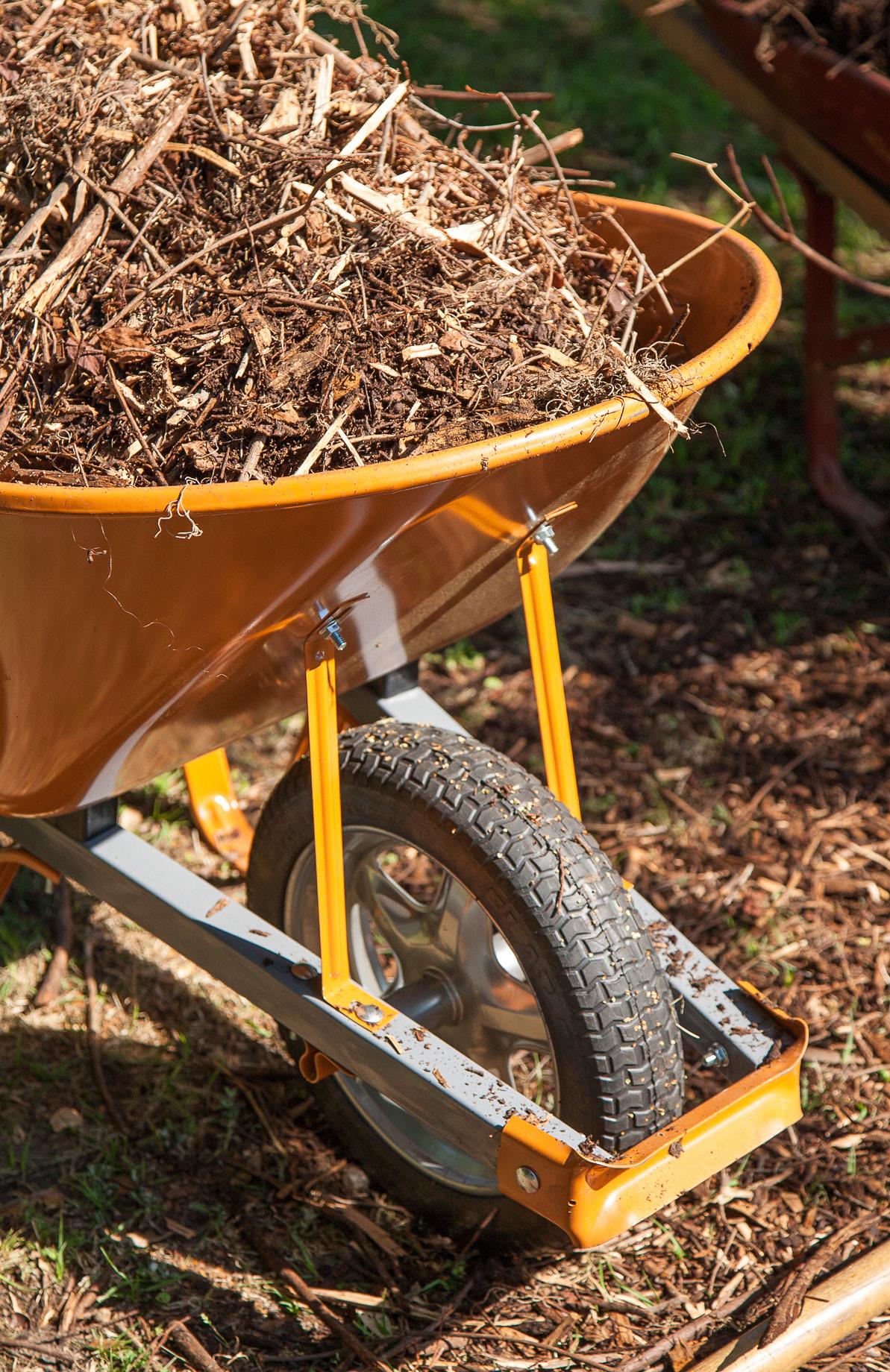




Trees clean the air by removing impurities and absorbing CO2, all while replenishing the atmosphere with oxygen.
Trees reduce water runoff into our rivers and marshes by mitigating the impact of rain and by filtering and absorbing stormwater.
Trees lower surface temperatures by providing shade for our homes, playgrounds, and surfaces such as streets, parking lots, and rooftops.
Trees reduce noise pollution by absorbing sound.
Trees lower energy costs by cooling homes in summer and blocking winds in winter.

Trees help reduce stress in the workplace and improve concentration in children.
Trees increase economic development by providing a positive image and attracting new residents, industry, and business.
Trees increase property values for homes, offices, and industrial sites.
Trees provide wildlife habitat by producing food and shelter for birds and animals.
Trees are beautiful and are an inherent part of Coastal Georgia’s character.
Planting a tree requires thoughtful preparation. The choices you make now will affect your property and community for years to come. Be sure to consider each of the following steps before you select a tree or break ground to plant it. Your goal is to get it RIGHT the first time to ensure long-term success.
Not all trees are appropriate for all locations. It is important to research the needs of a tree before planting it to make sure it will not cause damage to property or fail to thrive.
Choosing a healthy sapling is vital to growing a healthy tree. For best results, shop at a local nursery or shop Savannah Tree Foundation’s Native Tree Sale each fall!
Trees grow best when planted correctly and during the planting season. Avoid planting trees during the hot summer months. Coastal Georgia’s tree planting season runs November-March.
It is important to maintain the tree after it is planted. Have a plan to regularly water and mulch new trees, especially in summer!
“Right Tree, Right Place” is the number one motto when planting a tree. Here is what to consider when deciding what tree to plant where:
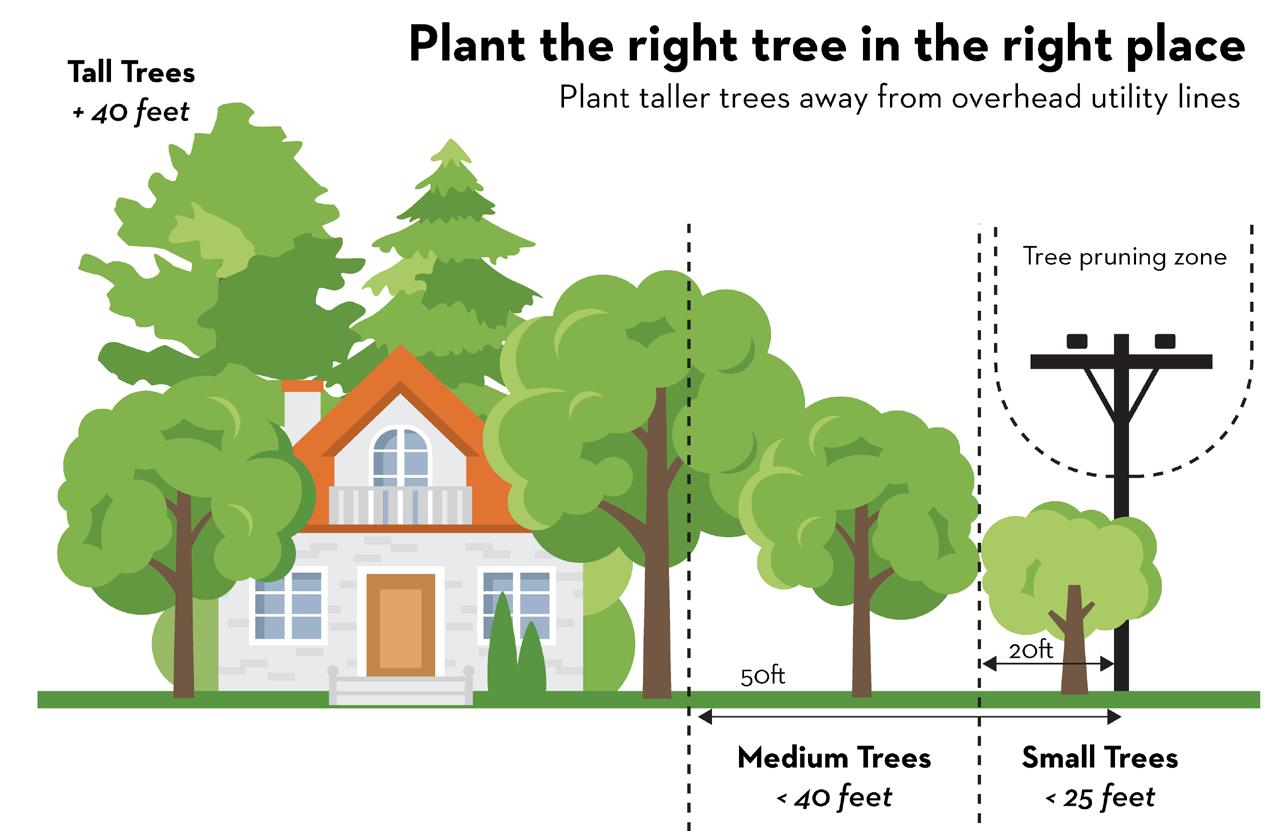
1. Height: Will the tree interfere with anything when it is fully grown?
2. Canopy Spread: How wide will the tree grow?
3. Root Space: Keep in mind that the roots can spread well beyond the canopy—up to 2 times the drip line!
4. Deciduous or Evergreen: Will it lose its leaves in the winter?
5. Form and Shape: An upright or columnar tree will grow in less space. Round and V-shaped species are spreading and provide the most shade.
6. Growth Rate: How long will it take for your tree to reach its full height? Slow growing species typically live longer than fast growing species.
7. Environmental Tolerances: Sun, salt, and moisture! What are the conditions like where you want to plant, and will the tree tolerate them?
8. Litter: Many trees have beautiful flowers, fruits, and seed pods, but will they be a nuisance where they fall?
9. Hardiness Zone: The USDA hardiness zone for Coastal Georgia is currently Zone 8b, though some maps show us moving towards 9a.
Choosing the right tree species to plant can be daunting. To make your decision easier, Savannah Tree Foundation has curated a list of recommended trees to plant in Coastal Georgia. You'll see the majority of the trees listed are native. Planting native trees is best, since they are more likely to thrive in our environment. Natives also create habitat and provide food for local wildlife. Check out our Local Tree List at the end of this booklet for species recommendations!
When selecting a tree, spacing is key. Our Local Tree List includes mature size of each species. Use that as a guide for selecting and spacing out trees to ensure their life-long health. The above spacing guide can help you select what size of tree you would like and where you can place it.
Planting trees around your home will conserve energy and lower the cost of utility bills. Three well-placed trees on the east, south, and west sides of a home will shade it from summer sun and lower air conditioning usage. Trees can reduce nearby air temperatures by as much as 9 degrees.
In the winter, trees act as windbreaks and can help reduce heating costs. Deciduous trees also provide winter benefits by allowing more sunlight to warm your home.
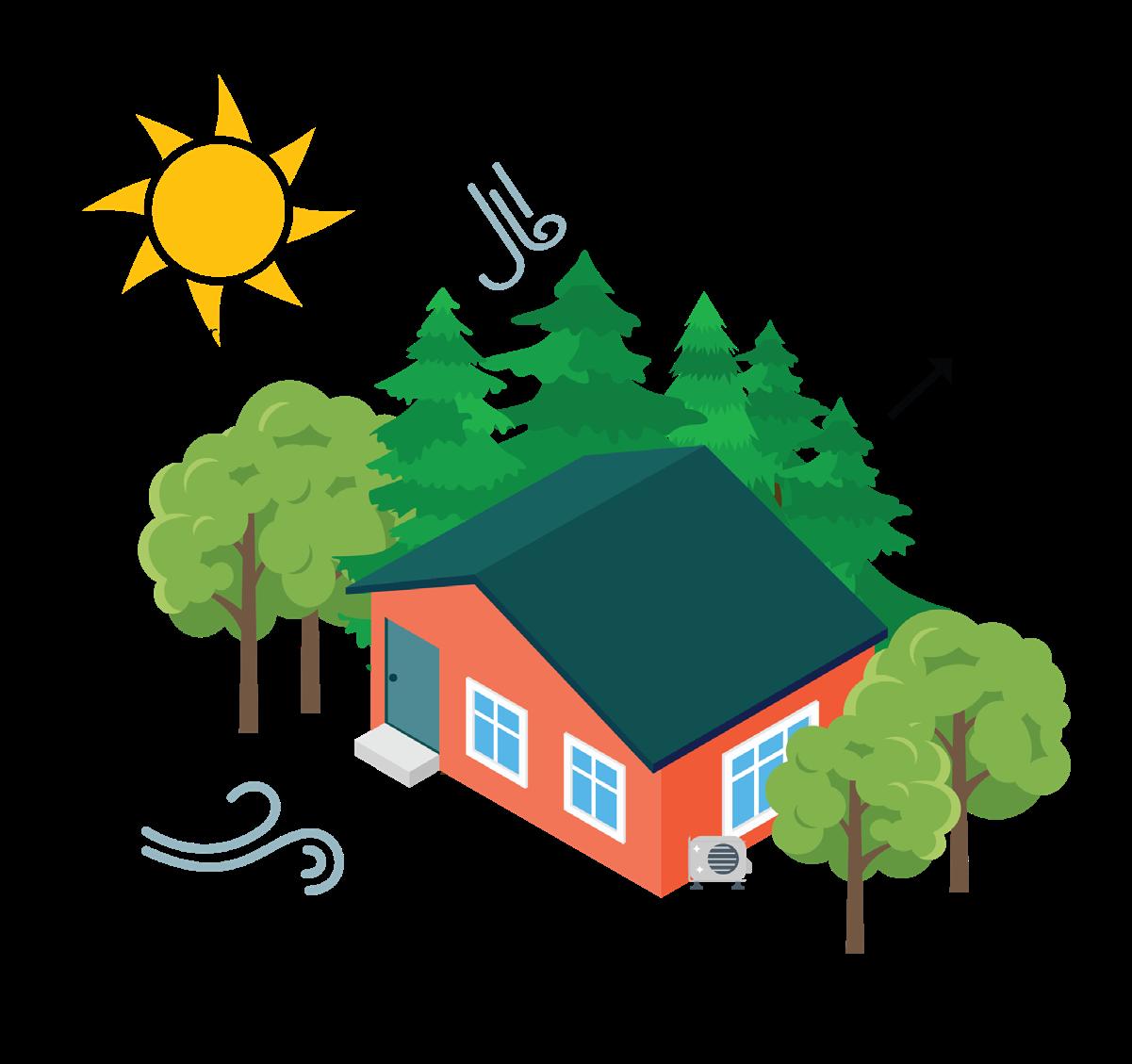
A tree is a long-term investment. Like any investment, you want the most bang for your buck. This means starting with good stock. The best places to buy trees are from regional growers where each tree has been grown in a climate similar to your own. Check out a local nursery, or shop Savannah Tree Foundation's Native Tree Sale each fall! WHAT
Container sizes range from small to large. Avoid trees that are root-bound. Circling or girdling roots can inhibit other roots and affect nutrient intake.
PROS: Affordable. Commonly carried by nurseries. Wide range of sizes.
CONS: More likely to have root issues, such as circling roots. Larger sizes are susceptible to transplant shock.
Small seedlings. Look for abundant and fibrous roots and good color. Bare root trees must have moist roots!
PROS: Inexpensive. Acclimate quickly. Require very little water and nutrients.
CONS: Easily damaged by vehicles or mowers. Can die quickly if roots dry out. Not visually impactful when planted.
Sold as larger trees. Look for a firm soil ball with trunk securely tied. Avoid trees with a broken ball or circling roots at the base of the trunk.
PROS: Less likely to have circling roots. More resistant to mechanical damage.
CONS: Expensive. Can be extremely heavy, requiring machinery to move. Susceptible to transplant shock.
Planting a tree correctly is one of the best things you can do to set it up for a lifetime of success. Follow these steps for a happy and healthy tree.
1. Call 811 before you dig! The Utilities Protection Center will locate and mark underground utilities within two business days of your call. This important step can prevent cutting through wires or plumbing pipes.
2. Dig a hole 2-3 times the diameter of the root ball or container and no deeper than the ball or the container. For planting bare-root seedlings, dig a hole wide enough so that the roots do not bend or form a “J”, and deep enough for all roots to be in contact with soil.
3. Identify the trunk flare. This is where the roots spread at the base of the tree. It should be partially visible after the tree is planted. You may have to remove soil from the root ball to expose the flare. Plant the tree with the flare 1 to 2 inches above ground level.
4. Remove container, cut circling roots, and place the tree. For balled and burlapped trees, remove all ties and strapping. For containerized trees, loosen roots to encourage outward growth. Place the root ball on firmly packed soil, with the trunk flare and inch or two higher than the existing soil line to allow for soil settling.
5. Refill the hole with the previously removed soil, then water. Using the soil removed from the hole encourages the tree's adaptation to its new location. Tightly pack the soil and water the tree as you fill to eliminate any airpockets. Check along the way that the tree remains straight.
6. Mulch the base of the tree with 2-4 inches of leaf litter, pine straw, shredded bark, or composted wood chips. Pull the mulch away from the trunk so the end result is a "donut" shape.
TIP #5: Make sure it's straight! It is hard to correct a poorly aligned trunk once the tree begins to grow,
Newly planted trees should NOT be fertilized. Tough love is best for young trees. This prompts them to adapt more quickly to their new soil conditions and encourages more rigorous root growth.
Newly planted trees should NOT be pruned except to remove broken or torn branches. The tree is already stressed by the transplant process and should not be additionally stressed by removing healthy branches.

Most small trees only need to be staked if wind is a significant issue. When staking, allow for slack in the ties, which should be wide nylon or canvas straps. Remove all stakes and ties after the first growing season to avoid the tree growing through them.
Keep the soil moist but not soaked. When soil is dry below the surface of the mulch, it's time to water. A good rule of thumb is to water your tree AT LEAST once per week when it has rained less than 1 inch.
Just a few simple maintenance practices can help keep your tree growing strong and healthy. With proper mulching, watering, and pruning, you can help your tree thrive!
Mulch is valuable for your tree's health and care: Organic mulch provides nutrients as it decomposes.
Mulch insulates the soil, helping to provide a buffer from heat and cold temperatures.
Mulch retains water, helping keep the soil moist.
Mulch helps control weeds and helps prevent lawn mower or weed-whacker damage.
1. Mulch out, not up. Spread mulch in a 2-4 inch layer, going out to the edge of the tree's canopy if possible.
2. Start mulching several inches from the trunk. If mulch is piled up near the trunk, it can cause insect and disease problems. Avoid overmulching in a "volcano" shape.
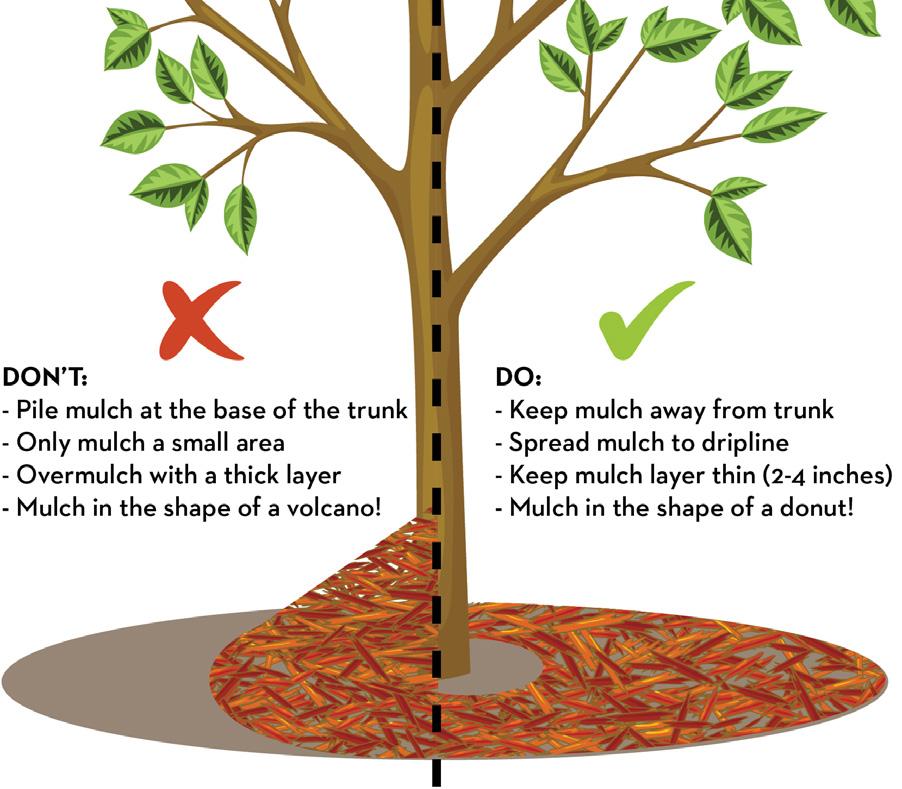
3. Use organic materials, such as leaves, wood chips, or bark pieces. You can allow fallen leaves to remain on the ground as mulch.
4. You can mulch any time of year. For maximum benefits, mulch in spring, when the soil begins to warm enough for root growth.
Watering is critical for tree growth and survival. Keeping the tree's root system moist but not flooded is key to preventing pests, disease, and general tree decline. When watering, remember that tree roots are generally shallow and expansive, located in the top 1218 inches of soil and extending beyond the tree's canopy.
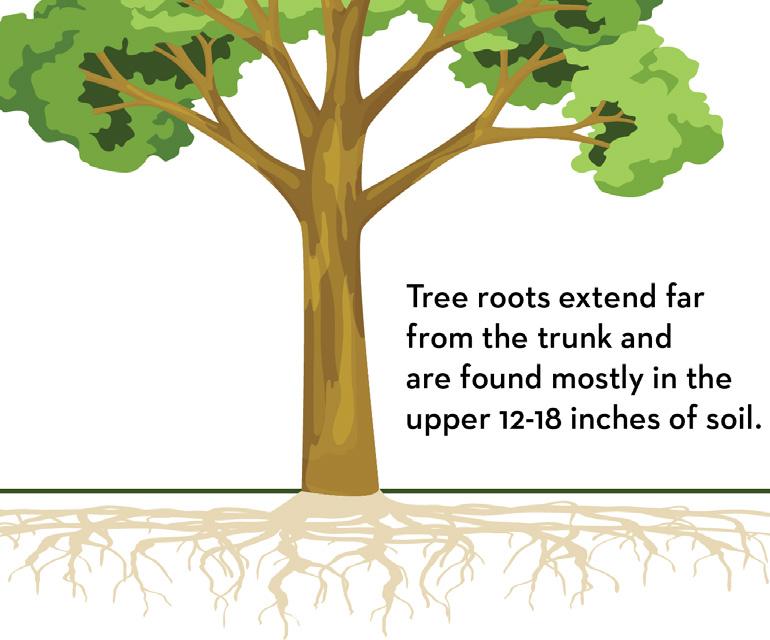
Newly planted trees require weekly watering. In weeks where it does not rain at least 1 inch, water trees at a rate of 10 gallons per inch of trunk diameter. This should be done for the first 1-2 years after planting.
Established trees should be watered every 2-4 weeks in drought conditions. Focus on thoroughly wetting the first 12 inches of soil under the tree's canopy. Ensuring sufficient watering using a hose or sprinkler system can take many hours for large trees, so patience is key. Too much water can kill a tree by eliminating air from the soil and suffocating roots. Check out our Local Tree List to learn more about a tree's water requirements and adjust accordingly.
The best time to water is at night when there is less evaporation loss. A few heavy waterings are better than frequent, shallow waterings.
Soaker hoses, slow-release watering bags, or drip irrigation are good ways to water. If you use a slowrelease watering bag (aka gator bag), remember to remove it after the first two growing seasons.

Do I need to fertilize my trees? In short, usually not. Tough love is the name of the game with young trees, and a decent soil will have enough nutrients to support most established trees. However, if a mature tree is showing signs of stress, such as dieback, it could mean it needs to be fertilized.
If you do apply fertilizer, the best time to apply is late winter or early spring. Fertilizer should be applied to moist soil and watered in afterward to improve intake and reduce chance of root injury.
Natural Areas: In nature, trees get nutrients from the air, organic matter, microbes, and soil minerals. Mimicking a natural habitat can reduce the need for fertilizer. For example, let leaves remain on the ground instead of raking them up or mulch your trees.
Urban Areas: In urban settings, lack of water and compacted soil limit growth of trees more than nutrient levels. Supplying adequate moisture and reducing soil compaction will increase fertility, microbial activity, and water retention—all factors that increase tree growth.
Start with pH: Before using any fertilizer, test your soil nutrient levels and pH. Adjusting to the proper pH can have a larger impact than just adding fertilizer. Soil testing is available through your local extension service.
When to use fertilizer: Once you have determined your soil is at an appropriate pH, you can then assess any nutrients that may be lacking. An extension service can recommend any amendments to your soil.
Caution: Excessive fertilizer application can increase the susceptibility to plant diseases, result in pest problems, and can “burn" roots. Only fertilize if your trees are in decline, or if it is recommended by an arborist.

TIP #8: Avoid fertilizing young trees. Fertilizer is only recommended for mature trees struggling due to damage, pests, or disease.
Pruning determines future shape, structural design, and health of a tree. Proper pruning enchances the beauty and health of a tree. Incorrect pruning or over-pruning can cause damage that lasts the lifetime of the tree. Given its importance, pruning is best done by a trained tree care professional. However, young trees can be pruned by do-it-yourselfers who are equipped with the correct knowledge and right tools.
Every pruning cut is a wound to the tree, so be thoughtful when planning to prune and remove as little as possible. New trees should only be pruned to remove broken or torn branches, as eliminating leaves during this important growth stage can harm root establishment.
Proper tools are essential. Most small tree pruning can be done with hand pruning shears. The bypass blade or scissor-like pruners are preferred as they make a cleaner, more accurate cut than the anvil type blade. Cuts over one-half inch in diameter should be made with a pruning saw. Cuts requiring power equipment are best left to the professionals. Be sure to disinfect your tools after each use!

The best time to prune a young tree is during the winter months, when trees devote fewer resources to canopy growth. Pruning during this time gives the tree time to recover from its wounds before spring. Removal of broken or hazardous branches may be done at any time.
Flowering trees should be pruned at key times to enhance blooms. For trees that flower in the summer or fall (e.g. crape myrtles), prune in the late winter or early spring. For trees that flower in early spring (e.g. redbud or dogwood), prune immediately after flowering.
Never prune trees that are touching or near utility lines. Instead, consult your local utility company.
#9: Only prune when necessary. Avoid excessive pruning, which can inhibit nutrient intake and create future structural issues.
Pruning cuts are permanent wounds that never truly heal, even when done correctly. It is best to limit the size of pruning cuts whenever possible.
Pruning cuts should be made at a node, the point where one branch attaches to another. Cuts made between nodes can lead to decay or excessive sprouting.
A proper pruning cut does not damage the branch bark ridge or the branch collar. Begin the cut outside the branch bark ridge and angle perpendicular to the branch, avoiding injury to the branch collar. This makes the smallest possible wound.



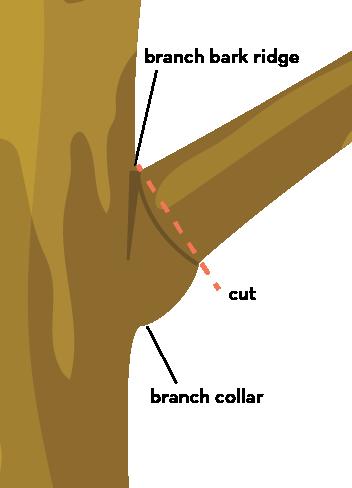
For larger branches, use a three-step pruning cut method to avoid ripping the bark, which destroys the nutrient pathways of the tree. This method also makes falling branches easier to control and is safest for novice pruners.
Improper pruning cuts cause tree injury, weaken a tree's structure, and make a tree susceptible to decay. Common mistakes include stub cuts, flush cuts, and topping.

Trees are a public good. This means their impact reaches far beyond the property on which they are planted. As you plant and maintain trees in your yard, it is helpful to think of how they will impact the community around them.
Thoughtful pre-construction planning can help save trees on your property. Trees are an important part of your investment. Mature trees lower energy costs, increase your property's value, and start you off with a beautiful landscape.
When planning a construction project, your first step should be to assess the trees already growing on your property. Consider hiring an arborist or landscape architect to determine what trees are valuable to you and which ones will be able to withstand the impact of construction.
Before any construction or clearing begins, it is important to install construction protection around the trees to be saved. The best means of protection is a construction fence around each tree. Fences should be placed with one foot of space away from the trunk for every inch of trunk diameter. The tree should be mulched and watered before, during, and after construction.
The tension between overhead utilities and trees is ongoing in Coastal Georgia, especially along our canopied roadways. Utility companies must provide safe, reliable service to their customers, but trees limbs hitting power lines are a major cause of electrical outages. It is crucial to plant the Right Tree in the Right Place to avoid future pruning issues.
When pruning is necessary, Savannah Tree Foundation encourages directional pruning, which removes only the branches growing towards the wires and ensures all cuts are made at a node. This method is structurally and biologically best for the tree. However, even when done properly, directional pruning can be unsightly. Strategies such as v-cutting or side cutting can help mitigate aethestic problems. If you have any questions about utility pruning, contact Georgia Power.
1-888-660-5890 georgiapower.com
When in doubt, it is best to bring in a professional to help with your trees. Check out the following resources when dealing with large trees, hazardous conditions, or special situations.

When working with large, mature trees, it is best to enlist the help of a professional for maintenance and pruning decisions. Savannah Tree Foundation recommends hiring a qualified, ISA-certified tree care professional. Certification by International Society of Arboriculture (ISA) ensures that your tree care professional has had proper training in all aspects of tree care. Find an up-to-date list of local arborists on the Savannah Tree Foundation website. savannahtree.org/downloads
If a tree is on public property, it is the municipality's responsibility to prune and care for the tree. Examples of municipal trees may include those in the "tree lawn" or in right-ofways along the road. If you see an issue with a tree you believe is publically-owned, contact your government officials.
Local extension services can help identify tree pests and diseases. They can also help with soil sample analysis. If you suspect you have an invasive pest or similar issue on your property, check out these resources: University of Georgia Extension: extension.uga.edu Georgia Forestry Commission: gatrees.org
Directly, no, but sometimes Spanish Moss can have indirect impacts on trees. It can get thick enough to cover leaves and reduce the tree’s ability to photosynthesize. During storms, the combination of wet Spanish Moss and strong winds can cause branch breakage.
What should I do if I am planning construction around my trees?
Many municipalities have standards in their tree ordinances for protecting trees during construction. You can check your municipality’s standards at savannahtree.org/downloads.
This is a common question in downtown Savannah, where “tree lawns” are frequent. A tree lawn is the green space between a sidewalk and curb. Within the City of Savannah, trees in tree lawns are the jurisdiction of the Greenscapes Division and should not be pruned or cut by residents. However, the ground cover (mulch, grass, etc.) in the tree lawn is the responsibility of the adjacent property owner.
What can I do if I have concerns about a tree that is not on my property?
If the tree is on municipal property, contact your government officials through the numbers listed on the previous page. If the tree's trunk is on private property, the tree is the responsibility of that owner, though the law does allow you to prune any branches that extend over your property.
Trees on public property are only allowed to be pruned or removed by the respective municipality. In most municipalities, people are free to manage trees on their personal property. However, some do require permits for tree work. If you are not sure, you can look at your municipality’s tree ordinance, found on our website at savannahtree.org/downloads.
It is a common misconception that pine trees are dangerous near homes. This is only true in certain scenarios. Pines can be susceptible to top breakage during severe storms when most of their branches and needles are located at the top of the tree. However, pines with a more even distribution of branches throughout the trunk are less susceptible. Additionally, pines in clusters are better shielded from extreme winds.
Red fall color. Intolerant of urban heat.
Multi-stemmed. Naturally peeling bark. Intolerant of urban heat.
Drops hickory nuts. Drops hickory nuts.
No Tolerance - N
Low Tolerance - L
Medium Tolerance - M High Tolerance - H
Various cultivars. Pink/purple flowers.
Edible fruit. White flowers. White, snowball-clustered flowers before leaves.
Golden yellow fall color.
Tough urban tree. Thornless cultivars available.
Small white flowers.
Fragrant white flowers. Small white flowers before leaves.
M M M N L L M N H L L N M M M N M H N N L L N N M M N N H H N N H M L N M L N N L L N L L H N M H L H N H L M N
Small white flowers before leaves.
Red berries.
Red berries. Spiny leaves.
Red berries.
Large walnuts can stain sidewalks.
Small juniper berries.
Various cultivars. Summer flowers.
Red to purple fall color. Spiky gumballs.
Orange and white flowers. Yellow fall color.
Large white flowers. Bright red seeds. Dwarf cultivars.
White flowers. Silver underside of leaves.
Pink flowers.
Edible berries can stain sidewalks.
Great for pollinators.
No Tolerance - N
Low Tolerance - L
Medium Tolerance - M
High Tolerance - H
M L M N H L H L H M L M M H N M L L N N M H L M L M N L L L L N L L N L H L N M M N L N L L N N H M M N H L L M
Wood strength comparable to hardwoods.
Habitat for endangered species. Fire-tolerant.
Most common southern pine.
Large, maple-like leaves. Naturally exfoliating bark.
Seeds with cotton-like strands in spring.
Edible fruit.
Wildlife habitat.
Red/orange fall color.
Great shade tree.
Red fall color.
Yellow fall color.
Red/brown fall color.
Dark red fall color.
Hop-like fruits. Strong wood. No Tolerance - N
Low Tolerance - L
Medium Tolerance - M High Tolerance - H
H M N N L L L N L M L N L L M N M L M N L M H M L N N L L M N M M M N M M L M N M H N N M N H N L L N N L L M L
Grows "knees" in wet areas.
Dutch elm-resistant cultivars.
Willow-shaped leaves.
Red fall color.
Red fall color.
State tree of Georgia. Strong wood.
Grows "knees" in wet areas.
Grows "knees" in wet areas.
Dutch elm-resistant cultivars.
No Tolerance - N
Low Tolerance - L
Medium Tolerance - M
High Tolerance - H
Volunteering with Savannah Tree Foundation is a fun and fulfilling way to learn about trees and to give back to your community.
Your one-time tax-deductible donation supports our educational opportunities, volunteer events, and tree plantings.
No Tolerance - N
Low Tolerance - L
Medium Tolerance - M
Sign up for an easy, recurring monthly donation, which allows us to sustainably protect and grow our urban forest.
High Tolerance - H
